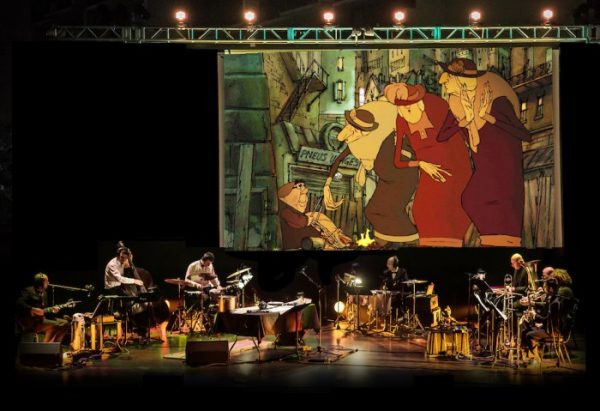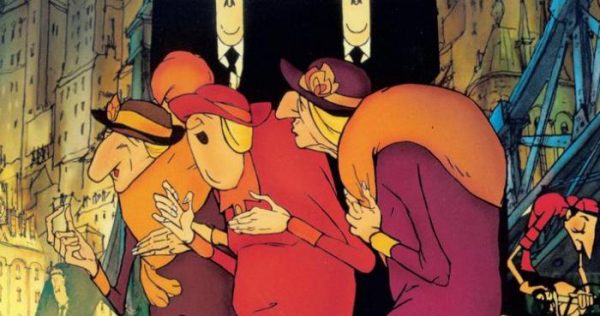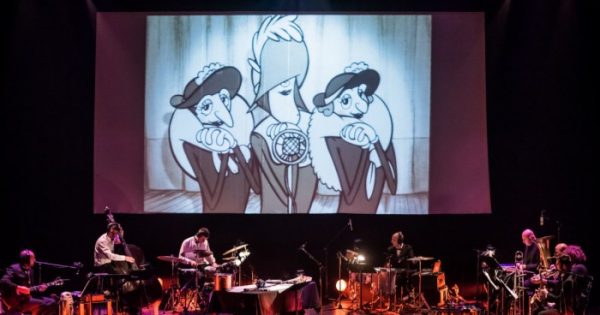The Triplets of Belleville (2003), a French-Canadian, wildly inventive and idiosyncratic animated film with no dialogue (just sound effects and simulated speech) has an exuberant original Oscar-winning soundtrack (more on that later). The plot is ostensibly about a boy, a dog, a grandmother and a bicycle, but it is really about the passing of time, aging, resilience and persistence. At the same time, it hints at a social critique of America while clearly a love letter to early Disney animation as well as a paean to those kitschy American gangster movies from the 1930’s. Add in a love affair with Hollywood’s movie musicals and you begin to sense the complexity here, as all this is served up with a dash of whimsy and with a deeply sardonic Gallic sense of humor.

Composer Benoit Charest and his Le Terrible Ochestre De Belleville accompany the screening of the film as they tour around the world playing at universities and colleges. Each of the musicians plays multiple instruments, along with producing the sound effects (much like radio used to do). This involves watching them rustle papers, bang musically on a steel rim of a bicycle wheel and other zany actions reminiscent of Spike Jones and Ernie Kovacs. Benoit has described Belleville as an “anti-Disney” film because “no one is cute here.” This is quite the understatement as many of the characters (especially a Josephine Baker-like character) are savagely drawn. Indeed there is a long tradition of trenchant French caricature exemplified by Daumier that borders on the brutal. This film clearly borrows from that edgy satiric tradition. Madame Souza (Grandma) is a case in point. She is a tiny force of nature though she has one foot shorter than the other and wears an elevated shoe (not that any of that slows her down).
At the beginning of the story, the odd two-story lighthouse-shaped structure that Mme. Souza and her orphaned grandson call home is shown in a sparsely populated rural village. Very quickly in a few frames, the village becomes a town, the town becomes a congested city strangling the old homestead. The final insult –if you may– is an elevated train bisecting the town that literally is only a hair’s length away from Grandma’s house. So close in fact, that the house has to perilously lean away from the tracks looming precariously like the famous Tower of Pisa. This is a masterful and somewhat melancholy vision of progress painted in somber blues and grays.

Grandma is in charge of her orphaned grandson who is truly sad until she gets him a cute bloodhound puppy (Bruno) and a tricycle, which he rides joyously and obsessively in circles. Time passes inexorably and the next time we see Bruno he is an elderly, massively overweight, possibly arthritic bloodhound teetering around on shaky stilt-like legs that seem barely able to support him. The little boy has grown into an attenuated zombie-like professional bicyclist who only eats, sleeps and trains. His streamlined body is hunched forward from riding constantly and his oddly shaped legs bulge weirdly like Popeye’s arms. Grandma feeds him, doggedly trains with him (with a whistle and a tricycle) and puts him to bed. Everyone has a purpose and a routine. Grandma is devoted to her grandson, who is devoted to racing and Bruno who is devoted to –well – the train that passes by regularly. Much fun is made of Bruno watching the clock and wobbling upstairs to bark hoarsely as the commuter train whizzes by. Then he gets up a head of steam as he pitches precariously downhill and cannot stop himself from sliding into the door — again and again.
This unfailing routine is interrupted when Champion (as the boy is now known) is kidnapped with three other Tour de France riders by several ominous figures clothed in black. This begins Grandma and Bruno’s decidedly madcap adventures as they try to free Champion. After crossing a large body of water in a purloined paddleboat while closely following the large ocean liner that the kidnapped riders are on, they all end up in Belleville (which could easily be New York in the 1930’s). The denizens of this mythical place are gargantuan, big in girth as well as height (a possible pointed critique of Americans with their big appetites and portions). It is here in a large venue, that we find the three kidnapped riders attached to racing bikes. Each has a screen with a black and white film of the Tour de France course on it and each zombie-like rider is peddling away vainly trying to win. The black-coated tombstone shaped figures are a mafia of sorts and there is heavy betting going on. The slick obsequious maître ‘d at this establishment is comically bent down sideways in a perennial kowtow position as he offers drinks to the ominous Mafia bosses.

Meanwhile Grandma who is penniless, has been taken in by the elderly Triplets of Belleville who were once revered nightclub entertainers in the 1920’s (an earlier scene has them singing the jaunty theme song Belleville rendez-vous.) The three gray-haired, pigeon-toed triplets sleep together in their humble apartment but offer Grandma the couch to sleep on. The refrigerator is empty but one of the triplets straps a stool to her behind and gamely sets out to catch dinner. She hurls a grenade into the nearby lagoon and when it explodes tons of frogs rain down on her and end up in her basket. Dinner is forever frogs (not even frogs legs). The ever inventive, perpetually happy Triplets then incorporate Grandma into their avant-garde performance which involves plucking the racks of the empty refrigerator, using a vacuum cleaner with Grandma contributing by banging on a bicycle rim (it’s a pleasure to watch the orchestra do all of this). As luck would have it, this is the very same club where the three kidnapped cyclists are busy pedaling away while the club goers drink and bet.
The wild and frenzied denouement that follows has the Triplets, Grandma and Bruno free Champion (though he doesn’t seem to know this). It’s like a Max Sennet comedy as our protagonists careen around the city trying to escape the mafia firing at them. Through sheer inventiveness—using hats, frying pans, and sheer luck, the motley crew escape their tormentors and is seen headed up an impossibly steep incline with Champion still obsessively pedaling, presumably headed home. The indefatigable Madame Souza is an unlikely heroine for the ages but her creativity, dedication and Gallic sangfroid make her unforgettable. The Triplets of Belleville is an extraordinary and haunting fable about the inexorable passing of time and the redemptive power of love and friendship.
Reprinted with permission from Riot Material (riotmaterial.com)
[alert type=alert-white ]Please consider making a tax-deductible donation now so we can keep publishing strong creative voices.[/alert]
